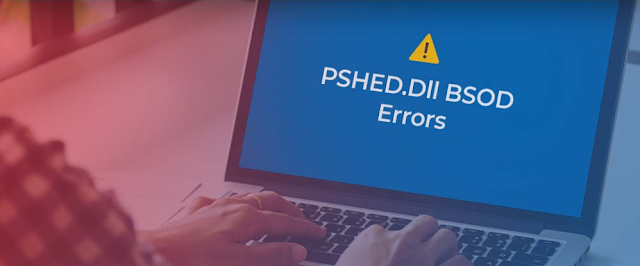Guide to Solve Pshed.dll BSOD Errors in Windows 10
A BSOD, also known as
a blue screen of death, occurs when a file fails to load. This error is a bug
check value of 0x124 that indicates that a fatal error has taken place. The
BSOD errors can be confusing for Windows users but are there for a specific
reason. Most of the time, the PC can recover as soon as the restart is carried
out, as this prevents the system from being damaged when a critical error
occurs. That's where the great news flies away, though, since repeated pshed.dll causing BSOD error might indicate that the hardware is failing. There isn't
much information given to those who encounter this error, despite it being
present in the system. In this blog, we will explain how to solve Pshed.dll
Windows 10 BSOD errors.
Steps To Solve Pshed.dll BSOD Errors
This Pshed.dll is a dynamic link library system file that is
referenced within the distinct BSOD error messages. The dump files of the BSOD
error messages indicate that it is the Pshed.dll driver that causes the errors.
There are various ways to solve the BSOD Pshed.dll errors, and below, you'll
see the ways to try and do that.
1. Run a Windows 10 Repair Utility Scan
Many of the third-party Windows 10 repair utilities can fix a
good range of BSOD errors. The system repair packages consist of scanning
options for hardware, stability, and security issues. After scanning the
system, it is assured that you can solve this issue with just a button click.
2. Update System Drivers
Update your system drivers, specifically pshed dll
driver, if you are experiencing this BSOD error and others. Outdated system
drivers are often the cause of BSOD errors. Using a dedicated tool to update
the drivers is much easier than manually updating them.
·
To update a driver, press Windows+X, then select the device
manager. Right-click a driver that you want to update, and then select the
Update driver option.
·
Once you have chosen the option Search automatically for the
updated driver software, you must follow the onscreen instructions.
·
Once you have done this, you must repeat the process for all
outdated drivers.
3. Run A SFC Scan
If you experience a pshed.dll error blue screen, running an SFC
scan will help you resolve the problem. Follow the steps below and make sure
you do not leave any steps out.
·
To open the command prompt, you must first push the Windows plus S
keys followed by cmd in the text box of the search tool. After that, you need
to right-click the command prompt and select run as administrator.
·
To start the SFC scan, you must type the following command:
DISM.exe /Online /Cleanup-image /Restorehealth and then press enter.
·
Next, run this command: SFC /scannow. After the scan completes,
restart your PC or laptop to preserve the changes.
4. Update The PC's BIOS & Stop Overclocking
Some users notice the pshed.dll BSOD error due to an
outdated BIOS. The BIOS is a software component that controls the operation of
the PC. If that doesn't work, try to stop overclocking.
·
The first step you need to do is press Windows + I at the same
time to open the settings app. Then, you need to click on Update and Security
and then select Recovery.
·
Afterward, select troubleshoot and advanced options from the blue
menu. On the next screen, press the restart now button.
·
When your PC is restarted, you should locate and open the
overclocking section. From there, you should disable all overclocking settings.
Now select the UEFI firmware settings and restart your PC.
It is possible to solve the majority of pshed.dll errors by
following these steps. Read and follow all the instructions carefully, and you
will indeed resolve this issue.
Related Links: administrator Account disabled on Windows 10



Comments
Post a Comment